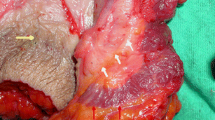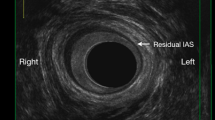Abstract
Purpose
This prospective, randomized, controlled trial was designed to compare the clinical, functional, and morphologic results of pneumatic balloon dilatation with lateral internal sphincterotomy for the treatment of chronic anal fissure.
Methods
All patients with symptomatic chronic anal fissure were randomly assigned to pneumatic balloon dilatation or lateral internal sphincterotomy and invited to complete a standardized questionnaire inquiring about their symptoms. Anal ultrasonography and anal manometry were performed before and six months after surgery. A proctologic examination was performed between the fifth and sixth postoperative weeks. Anal continence, scored by using a validated continence grading scale, was evaluated preoperatively at 1 and 6 weeks and at 12 and 24 months.
Results
Fifty-three patients, who satisfied selection criteria, were enrolled in the trial. Four patients (7.5 percent) were lost to follow-up. Twenty-four patients (11 males; mean age, 42 ± 8.2 years) underwent pneumatic balloon dilatation and 25 patients (10 males; mean age, 44 ± 7.3 years) underwent lateral internal sphincterotomy. Fissure-healing rates were 83.3 percent in the pneumatic balloon dilatation and 92 percent in the lateral internal sphincterotomy group. Recurrent anal fissure was observed in one patient (4 percent) after lateral internal sphincterotomy. At anal manometry, mean resting pressure decrements obtained after pneumatic balloon dilatation and lateral internal sphincterotomy were 30.5 and 34.3 percent, respectively. After pneumatic balloon dilatation, anal ultrasonography did not show any significant sphincter damage. At 24-month follow-up, the incidence of incontinence, irrespective of severity, was 0 percent in the pneumatic balloon dilatation group and 16 percent in the lateral internal sphincterotomy group (P < 0.0001).
Conclusions
As lateral internal sphincterotomy, pneumatic balloon dilatation grants a high anal fissure-healing rate but with a statistically significant reduction in postoperative anal incontinence.



Similar content being viewed by others
References
Rosen L, Abel ME, Gordon PH, et al. Practice parameters for the management of anal fissure. The Standards Task Force. The American Society of Colon and Rectal Surgeons. Dis Colon Rectum 1992;35:206–8.
Nelson RL. A review of operative procedures for anal fissure. J Gastrointest Surg 2002;6:284–9.
Madoff RD, Fleshman JW. AGA technical review on the diagnosis and care of patients with anal fissure. Gastroenterology 2003;124:235–45.
Khubchandani IT, Reed JF. Sequelae of internal sphincterotomy for chronic fissure-in-ano. Br J Surg 1989;76:431–4.
Renzi A, Brusciano L, Pescatori M, et al. Pneumatic balloon dilatation for chronic anal fissure: a prospective, clinical, endosonographic, and manometric study. Dis Colon Rectum 2005;48:121–6.
Jorge J, Wexner SD. The etiology and management of fecal incontinence. Dis Colon Rectum 1993;36:77–97.
Renzi A, Izzo D, Di Sarno G, Izzo G, Di Martino N. Stapled transanal rectal resection to treat obstructed defecation caused by rectal intussusception and rectocele. Int J Colorectal Dis 2006;21:661–7.
Pescatori M, Anastasio G, Bottini C, Mentasti A. New grading and scoring for anal incontinence: evaluation of 355 patients. Dis Colon Rectum 1992;35:482–7.
Nothmann BJ, Schuster MM. Internal anal sphincter derangement with anal fissures. Gastroenterology 1974;67:216–20.
Altomare DF, Rinaldi M, Milito G, et al. Glyceryl trinitrate for chronic anal fissure-healing or headache? Results of a multicenter, randomized, placebo-controlled, double-blind trial. Dis Colon Rectum 2000;43:174–81.
Carapeti EA, Kamm MA, McDonald PJ, Chadwick SJ, Melville D, Philips RK. Randomised controlled trial shows that glyceryl trinitrate heals anal fissure, higher doses are not more effective, and there is a high recurrence rate. Gut 1999;44:727–30.
Maria G, Cassetta E, Gui D, Brisinda G, Bentivoglio AR, Albanese A. A comparison of botulinum toxin and saline for the treatment of chronic anal fissure. N Engl J Med 1998;22:217–20.
Jost WH. One hundred cases of anal fissure treated with botulin toxin: early and long-term results. Dis Colon Rectum 1997;40:1029–32.
Eisenhammer S. The surgical correction of chronic anal (sphincteric) contracture. S Afr Med J 1951;25:486–9.
Bennet RC, Goligher JC. Results of internal sphincterotomy for anal fissure. BMJ 1962;2:1500–3.
Hardy KJ. Internal sphincterotomy: an appraisal with special reference to sequelae. Br J Surg 1967;54:30–1.
Notaras MJ. Lateral subcutaneous sphincterotomy for anal fissure: a new technique. J R Soc Med 1969;62:713.
Hawley PR. The treatment of chronic fissure in-ano: a trial of methods. Br J Surg 1969;56:915–8.
Hoffman DC, Goligher JC. Lateral subcutaneous internal sphincterotomy in treatment of anal fissure. BMJ 1970;3:673–5.
Abcarian H. Surgical correction of chronic anal fissure: results of internal sphincterotomy vs. fissurectotomy midline sphincterotomy. Dis Colon Rectum 1980;23:31–6.
Pernikoff BJ, Einsenstat TE, Rubin RJ, Oliver GC, Salvati EP. Reappraisal of partial lateral internal sphincterotomy. Dis Colon Rectum 1994;37:1291–5.
Wiley M, Day P, Rieger N, Stephens J, Moore J. Open vs. closed lateral internal sphincterotomy for idiopathic fissure-in-ano: a prospective, randomized, controlled trial. Dis Colon Rectum 2004;47:847–52.
Allingham W. Diseases of the rectum. New York: Bermingham, 1882.
Tuttle JP. A treatise on diseases of the anus, rectum and pelvic colon. New York: D Appleton, 1902.
Hirschman LJ. Hand book of diseases of the rectum. St Louis: CB Mosby, 1914.
Goligher JC. Surgery of the anus rectum and colon. London: Baillière Tindall, 1980:145.
Jensen SL, Lund F, Nielsen OV, Tange G. Lateral subcutaneous sphincterotomy versus anal dilatation in the treatment of fissure in ano in outpatients: a prospective randomised study. BMJ 1984;289:528–30.
Marby M, Alexander-Williams J, Buchmann P, et al. A randomized controlled trial to compare anal dilatation with lateral subcutaneous sphincterotomy for anal fissure. Dis Colon Rectum 1979;22:308–11.
Weaver RM, Ambrose NS, Alexander-Williams J, Keighley MR. Manual dilatation of the anus vs. lateral subcutaneous sphincterotomy in the treatment of chronic fissure-in-ano: results of a prospective, randomized, clinical trial. Dis Colon Rectum 1987;30:420–3.
Nielsen MB, Ras Mussen O, Pedersen JF, Christiansen J. Risk of sphincter damage and anal incontinence after anal dilatation for fissure in ano. An endosonographic study. Dis Colon Rectum 1993;36:677–80.
Sohn N, Eisemberg MM, Weinstein MA, Lugo RN, Ader J. Precise anorectal sphincter dilatation: its role in the therapy of anal fissures. Dis Colon Rectum 1992;35:322–7.
Walfish S, Silberstein E. Balloon anal dilatation for anal fissure. Tech Coloproctol 1998;2:73–5.
Author information
Authors and Affiliations
Corresponding author
Additional information
Reprints are not available.
About this article
Cite this article
Renzi, A., Izzo, D., Di Sarno, G. et al. Clinical, Manometric, and Ultrasonographic Results of Pneumatic Balloon Dilatation vs. Lateral Internal Sphincterotomy for Chronic Anal Fissure: A Prospective, Randomized, Controlled Trial. Dis Colon Rectum 51, 121–127 (2008). https://doi.org/10.1007/s10350-007-9162-7
Received:
Revised:
Accepted:
Published:
Issue Date:
DOI: https://doi.org/10.1007/s10350-007-9162-7




